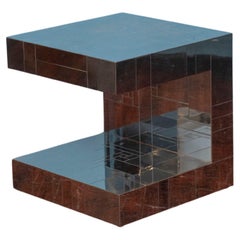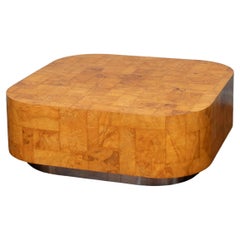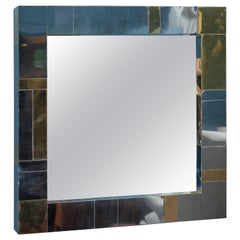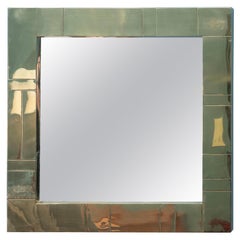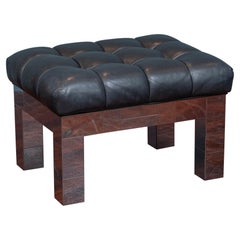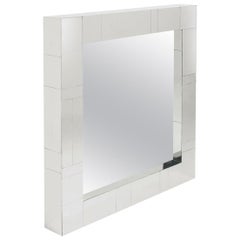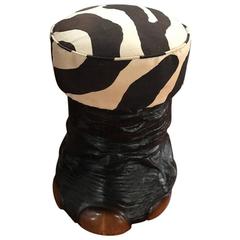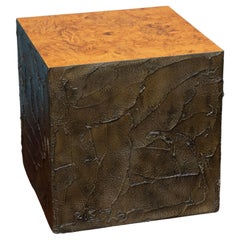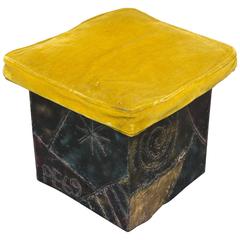Paul Evans Furniture
A designer and sculptor, Paul Evans was a wild card of late 20th century modernism. A leading light of the American Studio Furniture movement, Evans’s sideboards, credenzas, coffee tables and other work manifests a singular aesthetic sense, as well as a seemingly contradictory appreciation for both folk art forms and for new materials and technologies.
Evans’s primary material was metal, not wood, which was favored by his fellow studio designers, and Bucks County, Pennsylvania, neighbors George Nakashima and Phillip Lloyd Powell. He trained in metallurgy and studied at the Cranbrook Academy of Art, the famed crucible of modern design and art in suburban Detroit. For a time early in his career, Evans also worked at Sturbridge Village, a historical “living museum” in Massachusetts, where he gave demonstrations as a costumed silversmith.
Evans’s earliest work unites these influences. The pieces that made his reputation are known as “sculpted-front” cabinets: wood cases faced with box-like high-relief patinated steel mounts laid out in a grid pattern. Each mount contains a metal emblem, or glyph, and the effect is that of a brawny quilt.
Evans’s later work falls into three distinct style groups. His sculpted-bronze pieces, begun in the mid-1960s, show Evans at his most expressive. He employed a technique in which resin is hand-shaped, and later sprayed with a metal coating, allowing for artistic nuance in the making of chairs, tables and case pieces. Later in the decade and into the 1970s, Evans produced his Argente series for celebrated manufacturer Directional (a brand known to vintage mid-century modern furniture collectors everywhere): consoles and other furniture forms that feature aluminum and pigment-infused metal surfaces welded into abstract organic forms and patterns.
Last, Evans's Cityscape design series — a milestone in the history of brutalist design — meshed perfectly with the sleek, “high tech” sensibility of the later ’70s. Evans constructed boxy forms and faced them with irregular mosaic patterns that mixed rectangular plaques of chromed steel, bronze or burlwood veneer. These, like all of Paul Evans’s designs, are both useful and eye-catching. But their appeal has another, more visceral quality: these pieces have clearly been touched by an artist’s hand.
Find a collection of authentic Paul Evans furniture today on 1stDibs.
1970s American Mid-Century Modern Vintage Paul Evans Furniture
Chrome
1960s American Mid-Century Modern Vintage Paul Evans Furniture
Chrome
1970s American Mid-Century Modern Vintage Paul Evans Furniture
Brass, Chrome
1970s American Mid-Century Modern Vintage Paul Evans Furniture
Brass
1960s American Mid-Century Modern Vintage Paul Evans Furniture
Chrome
Late 20th Century North American Mid-Century Modern Paul Evans Furniture
Chrome
1970s Mid-Century Modern Vintage Paul Evans Furniture
1960s American Brutalist Vintage Paul Evans Furniture
Bronze, Copper, Steel, Pewter
20th Century Italian Paul Evans Furniture
Steel
20th Century Spanish Mid-Century Modern Paul Evans Furniture
Bamboo, Wicker, Cane, Rattan
21st Century and Contemporary American Modern Paul Evans Furniture
Stainless Steel
1970s American Brutalist Vintage Paul Evans Furniture
Slate, Brass, Copper, Steel, Pewter
1970s American Mid-Century Modern Vintage Paul Evans Furniture
Chrome
1970s American Vintage Paul Evans Furniture
Chrome, Metal
1970s American Mid-Century Modern Vintage Paul Evans Furniture
Metal
Mid-20th Century American Mid-Century Modern Paul Evans Furniture
Chrome
1970s American Mid-Century Modern Vintage Paul Evans Furniture
Chrome
1970s American Mid-Century Modern Vintage Paul Evans Furniture
Plaster, Burl
1960s American Brutalist Vintage Paul Evans Furniture
1970s American Mid-Century Modern Vintage Paul Evans Furniture
1960s American Mid-Century Modern Vintage Paul Evans Furniture
1960s American Brutalist Vintage Paul Evans Furniture
Brass, Steel
1960s American Brutalist Vintage Paul Evans Furniture
Metal
